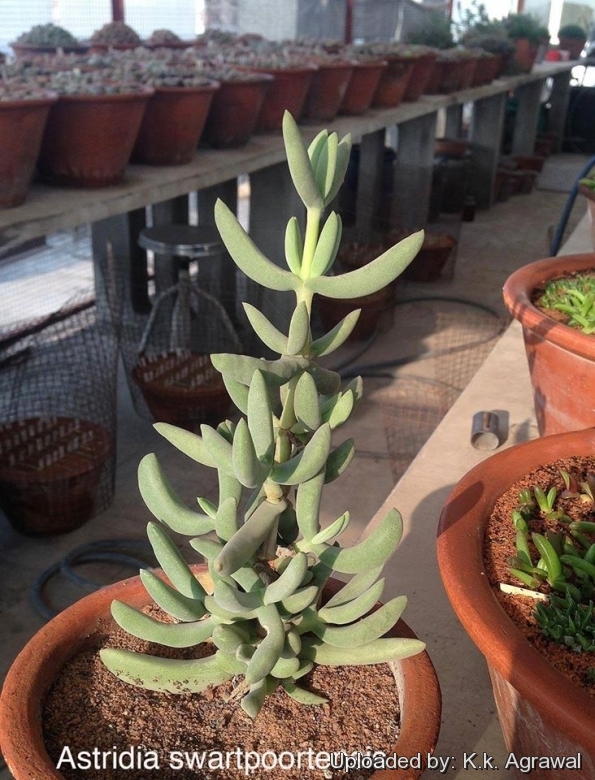Accepted Scientific Name: Astridia speciosa L. Bolus
J. S. African Bot. 27: 111 1961

Astridia swartpoortensis Photo by: K.k. Agrawal
Origin and Habitat: Swartpoort , Richtersveld, Namaqualand. South Africa
Habitat and ecology: Astridia swartpoortensisSN|28039]]SN|28039]] is a range-restricted species that grows in gravelly soil near rocks. It is threatened by habitat degradation, mining and collection.
Synonyms:
See all synonyms of Astridia speciosa
back
Accepted name in llifle Database:Astridia speciosa L. BolusJ. S. African Bot. 27: 111 1961Synonymy: 2
back
Description: Astridia swartpoortensis is a local or morphological form of Astridia speciosa from Swartpoort (hence the name), and the two plants are not readily distinguishable, if not for the geographical provenance. It is a small succulent shrub up to 3o cm tall with long curved pink velvety leaves. It has exceptionally pretty red flowers, the largest flowers in the genus, but several other species are very close to it. The fruit has conspicuous distinctive raised rims.
Stem: Erect with visible intenodes.
Leaves: Semi-lunate, 3-angled, long persistent, shortly fused at base, 35-50 mm long, 10-16 mm broad, 18-20 mm thick, epidermal papillae long.
Flowers: Daisy-like, 35-55 mm across, petals red to purple, their bases white, filamentous staminodes broad, yet surrounding the central column of stamens, white or yellow, their tips often red, overtopping the stamens.
Fruits (capsules): 6-locular and of the Ruschia type, ca. 20 mm long, with no valve wings, with well developed covering membranes and closing bodies, rims 3-4 mm hight.
Seeds: The distant papillae higher than broad, elongating gradually towards the micropyle, ca. 1.5 mm long,1 mm broad
Similar species: Because of similarities in the flower, this name has often been used for plants of Astridia longifolia, from which A. swartpoortensis differs mainly by the semi-lunate pink tomentose leaves. This leaf shape, however, A. swartpoortensis shares with Astridia vanheerdei.
Subspecies, varieties, forms and cultivars of plants belonging to the Astridia speciosa group
- Astridia speciosa L. Bolus: has erect stems to 30 cm tall with visible intenodes, red flowers and the fruit has conspicuous distinctive raised rims. Distribution: S-W namibia and N.Namaqualand, N. Cape, South Africa.
 Astridia swartpoortensis L. Bolus: has long curved pink velvety leaves. Distribution: Swartpoort , Richtersveld, Namaqualand. South Africa.
Astridia swartpoortensis L. Bolus: has long curved pink velvety leaves. Distribution: Swartpoort , Richtersveld, Namaqualand. South Africa.
Bibliography: Major references and further lectures
1) Heidrun E.K. Hartmann "Illustrated Handbook of Succulent Plants: Aizoaceae A-E" Springer Science & Business Media, 2002
2) Doreen Court “Succulent Flora of Southern Africa” CRC Press, 01/Jun/2000
3) Ed Storms “Growing the Mesembs” Tarrant Printing, 1976
4) Victor, J.E. 2005. Astridia speciosa L.Bolus. National Assessment: “Red List of South African Plants” version 2014.1. Accessed on 2014/07/12
5) James Cullen, Sabina G. Knees, H. Suzanne Cubey “The European Garden Flora Flowering Plants: A Manual for the Identification of Plants Cultivated in Europe, Both Out-of-Doors and Under Glass” Cambridge University Press, 11/Aug/2011
6) Gideon Smith “Mesembs of the World: Illustrated Guide to a Remarkable Succulent Group” Briza Publications, 1998
7) Hugh Francis Glen “Numerical taxonomic studies in the subtribe Ruschiinae (Mesembryanthemaceae) - Astridia, Acrodon and Ebracteola” In: Bothalia. 16: 203–226 1986
Cultivation and Propagation: The Astridia swartpoortensisSN|28039]]SN|28039]] is a "winter" grower which is most active from late winter until later spring and heading for summer dormancy, but in favourable growing conditions it keeps going over the summer too and doesn't need particular care.
Soil: Requires good drainage as it it is prone to root rot. It can grows outdoor in sunny, dry, rock crevices (protection against winter wet is required) It can also be cultivated in alpine house, in poor, drained soil.
Fertilization: It thrives in poor soils and seems sensitive to an excess of potassium.
Watering: Water minimally in summer, only when the plant starts shrivelling, water more abundantly when they are growing in the autumn and spring. Requires little water otherwise its epidermis breaks (resulting in unsightly scars).
Light: It needs a bright sunny or light shade exposure in winter, but keep cool and shaded in summer.
Hardiness: It prefer a very bright situation and will take a light frost (Hardy to -5°C) if it is in dry soil. USDA zones 9A – 11.
Uses: Container, rock garden.
Propagation: Seed in spring or cuttings. It is easily propagated by seed.










